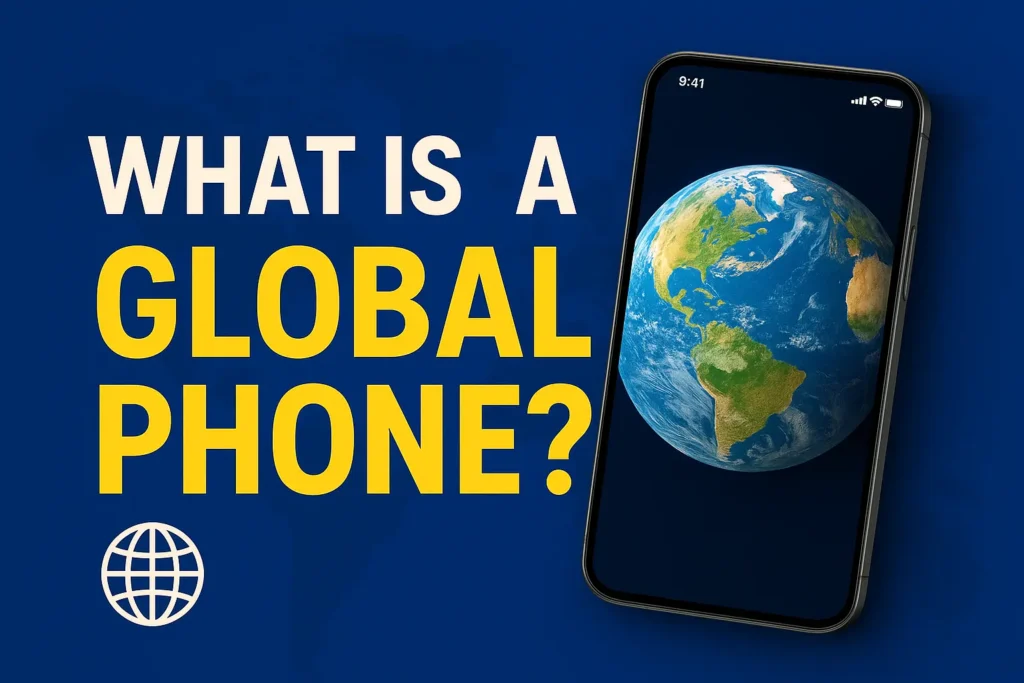In today’s connected world, travel and communication go hand in hand. Whether you’re a business traveler, a student studying abroad, or someone who loves exploring different countries, having a global phone has become more than just a luxury — it’s a necessity. But what exactly does the term “global phone” mean? And why is it so important for modern mobile users? Let’s find out.

Table of Contents
What Is a Global Phone?
A global phone is a smartphone designed to work seamlessly across multiple countries and cellular networks around the world. Unlike regular phones that are often “locked” to a single carrier, a global phone supports multiple frequency bands and SIM technologies, making it compatible with international networks.
In simple terms, a global phone allows you to insert local SIM cards wherever you go — without worrying about compatibility or connectivity issues. It’s the ideal solution for travelers who want uninterrupted calls, data, and messaging services in different regions.
How Does a Global Phone Work?
A global phone works through multi-band technology. It supports both GSM (Global System for Mobile Communications) and CDMA (Code Division Multiple Access) networks — two major mobile standards used globally.
Modern global phones also support 5G, 4G LTE, and VoLTE services, ensuring fast internet and crystal-clear calls across continents. Here’s how it functions:
- Multi-Band Support – Global phones include hardware components that detect various frequency ranges used by carriers worldwide.
- Dual-SIM Functionality – Most global phones come with dual SIM slots — one for your home country and another for local international use.
- Unlocked Device – Global phones are usually unlocked, allowing you to use SIM cards from any carrier globally.
- Automatic Network Switching – Some models can automatically choose the best available network based on your location.
With these features, a global phone ensures reliable coverage wherever you travel.
Why You Need a Global Phone
Owning a global phone comes with practical advantages that make life easier for travelers and professionals.
- International Compatibility: Use your phone in over 200 countries without technical issues.
- Cost Savings: Avoid expensive international roaming charges by using local SIM cards.
- Convenience: Stay connected with family and work wherever you are.
- Freedom of Choice: No carrier restrictions — switch networks anytime.
- Future-Ready: Works with next-gen 5G and satellite connectivity.
If you’re constantly on the move or deal with international clients, a global phone can be a real game-changer.
Best Global Phones in 2025
When choosing the best global phone, you need to focus on compatibility, battery life, and 5G network support. Here are some top picks for 2025:
- Apple iPhone 15 Pro Max (Global Edition) – Works on more than 250 carrier networks worldwide with eSIM support.
- Samsung Galaxy S24 Ultra – Offers exceptional 5G speed and international dual-SIM capabilities.
- Google Pixel 9 Pro – Known for its universal band support and AI-driven network optimization.
- OnePlus 12R Global Version – Great for travelers, combining performance and connectivity.
- Xiaomi 14 Ultra (Global Variant) – Affordable and efficient with broad international coverage.
Each of these global phones is engineered for compatibility across regions, making them perfect for cross-border communication.
How to Know If Your Phone Is Global
You can check if your phone is a global phone by verifying the following:
1. Unlocked Status: Go to your network settings — if your device allows any SIM, it’s global.
2. Supported Bands: Check your phone’s specifications on the manufacturer’s website.
3. Model Number: Global models usually have “Global” or “International” listed in their name.
4. Dual-SIM or eSIM Support: Global phones often feature multiple SIM slots or built-in eSIM technology.
Final Thoughts
The future of communication is borderless — and global phones are leading that change. They give users the freedom to travel, work, and connect from anywhere without losing network access or paying extra roaming charges.
If you’re buying a new device this year, make sure to pick a global phone that matches your travel needs, supports 5G, and offers broad frequency compatibility. It’s not just a smartphone — it’s your passport to global connectivity.